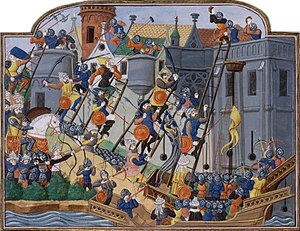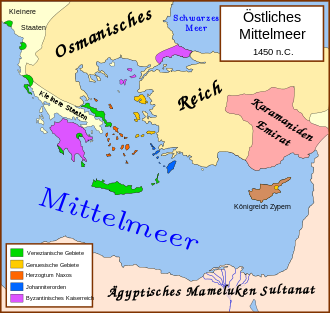Fall of Constantinople
Conquest of Constantinople
Part of: Turkish Wars

The Conquest of Constantinople, contemporary French miniature
Byzantine-Ottoman Wars
Bapheus - Catalan campaign - Bursa - Pelecanon - Nicaea - Nicomedia - 1st Gallipoli - Adrianople - 2nd Gallipoli - Philadelphia - 1st Constantinople - Thessalonica - 2nd Constantinople
The conquest of Constantinople in 1453 (it is also spoken of the fall of Constantinople) by a siege army of about 80,000 men of the Ottoman Sultan Mehmed II ended the Byzantine Empire. The defense of the city was the responsibility of Emperor Constantine XI, who had 7000 to 10,000 soldiers at his disposal and in all probability fell during the final assault on the city.
The fall of the Byzantine Empire also marked the final rise of the Ottoman Empire as a great power. In both Turkish and Western European reception, the conquest has a high symbolic value; depending on the perspective, it is seen as a sign of imperial greatness or as a beacon of decay and downfall. In historiography, the conquest of Constantinople is sometimes cited as one of the events that mark the transition from the European Middle Ages to the modern era.
Background
The conquest of Constantinople saw the clash of two empires with completely different starting points. The formerly powerful Byzantine Empire (also called the Eastern Roman Empire) looked back on a history of almost a thousand years, but since the second half of the 11th century was marked by a creeping decline. In the east, the Turkish Seljuks harassed the Byzantine Empire and, with their victory at the Battle of Manzikert, initiated the gradual conquest of Asia Minor, which meant the gradual loss of the populous "granary" of Anatolia. In the west, Greek-speaking and Orthodox Byzantium was threatened by the "Latin" powers of Catholic Europe, especially Venice. The capital Constantinople, which had an estimated population of 400,000 to 500,000 in the so-called Middle Byzantine period (roughly mid-7th to early 13th century), had been unsuccessfully besieged several times in its history, but finally fell into "Frankish" hands in 1204 during the Fourth Crusade (→ Latin Empire). Although the city was recaptured in 1261, the empire was restored only on a comparatively modest scale. Moreover, from the 14th century onwards it was increasingly harassed by the Ottoman Empire and gradually lost a large part of its territory to it. The capital Constantinople was able to repel a total of five sieges by Ottoman armies from 1391 onwards. At the time of the conquest in 1453, Constantinople had only an estimated 40,000 inhabitants, and the Byzantine Empire consisted only of the capital and its wider environs, some islands in the northern Aegean (Lemnos, Samothrace, and Imbros), and most of the Peloponnese, the so-called autonomous despotate of Morea. The final years of the Byzantine Empire were marked by increasingly desperate attempts to obtain military aid against the Ottomans from the so-called "Latin West" (i.e., predominantly Catholic Europe). In the end, Emperor John VIII Palaiologos even went so far as to effect union with the Catholic Church at the Council of Ferrara/Florence in return for a crusade against the Ottomans, largely accommodating the demands of the papacy.
The Ottoman Empire, in contrast, had only been founded in Söğüt in 1299 and experienced an enormous and continuous expansion in the first hundred years of its existence. This occurred initially in Asia Minor both at the expense of the Byzantine Empire and other Turkish dominions or beyliks. In 1369 the expansion of the dominion over the Dardanelles to Europe succeeded and the conquest of the so far Byzantine Adrianople (today: Edirne), which became the new capital of the Ottoman Empire. Through further military victories over Serbia (1371 at Maritsa and 1389 on the Field of Blackbirds), Bulgaria (tributary since 1388) and a crusader army (1396 at Nicopolis), the rule over the new territories could be secured in the long term. Under Sultan Bayezid I Constantinople was besieged several times (1391, 1394-1396 as well as 1397-1402), but unsuccessfully.
For the Ottoman Empire, the first half of the 15th century was marked by military threats from outside, rebellions and political conflicts at home. For example, the siege of Constantinople had to be broken off in 1402, as the Timurid Empire, newly established in Persia, threatened the Ottoman Empire on its eastern border. After the defeat of the Ottomans by Timur Lenk at the Battle of Ankara in 1402, an internal political conflict over the succession to the throne followed until 1413 (the so-called Ottoman Interregnum), in which Mehmed I finally prevailed and stabilized the empire. His son Murad II made another unsuccessful attempt to conquer Constantinople in 1422. After a long and costly war in the Balkans, Murad concluded a ten-year peace with his enemies there in 1444 and abdicated the throne in favor of his son Mehmed II, who was only fourteen years old. That same year, the Kingdom of Poland and the Kingdom of Hungary took advantage of their perceived weakness to attack the Ottoman Empire. Murad returned from retirement, still in 1444 defeated the Christian troops lining up as the Crusader army in the Battle of Varna, and in response to an uprising by the Janissaries formally resumed rule from 1446. Until his death in 1451, he achieved further victories in Europe and Asia Minor, so that his son, now nineteen years old, took over an internally stable empire with secure borders.
While Murad II had maintained a thoroughly friendly relationship with the tributary Byzantine Empire in his old age, Mehmed II made little secret of his desire to conquer Constantinople. After all, Constantinople's constricted position between the European and Asian parts of the Ottoman Empire made its further expansion difficult. Above all, the transport of troops between Europe and Asia proved difficult for the Ottomans due to Christian dominance at sea. In addition, Constantinople was an important trading and goods transhipment center with still great riches. Even though the Byzantine emperor was a vassal of the Ottoman sultan, he still secured Christian control of the Bosphorus and its important trade routes (Silk Road) for Western European, especially Italian, merchants. The Italian maritime republics, which were the Ottoman Empire's strongest competitors for control of the eastern Mediterranean or Black Sea, used Constantinople as a secure base for their economic and military operations. Given the good position created by Murad's last campaigns, the opportunity for an attack on Constantinople seemed favorable.

Expansion of the Byzantine and Ottoman Empires around 1450
Follow
The consequences of the conquest of Constantinople were far-reaching and manifested themselves in different contexts.
Politically, the conquest of Constantinople was one of the essential building blocks that secured the emerging Ottoman Empire a place among the great powers of Europe and the Middle East in the centuries to come. Very directly, it consolidated its rule, in particular by uniting the Asia Minor and European parts of the empire, and thus laid the foundations for the empire's further expansion. Thus, on June 3, 1453, only a few days after the conquest of Constantinople, the Genoese colony of Pera also had to submit to Sultan Mehmed. The Byzantine islands of Lemnos and Imbros, lying in the North Aegean, were also conquered in the same year. The despotate of Morea, as the last direct remnant of the formerly powerful Byzantine Empire, finally fell in 1460. The Byzantine Empire and the political entities that had emerged from it were thus finally eliminated. For the Italian cities (especially Venice and Genoa), which were heavily involved in the eastern Mediterranean and the Black Sea, the loss of control of the Bosporus was a severe blow that henceforth affected their Black Sea and Levant trade.
Another consequence of the conquest of Constantinople was the emigration of many Greek scholars to the Latin West, especially to Italy. In conjunction with the parallel emergence of printing, their teachings and the ancient writings they brought with them quickly spread. Although this process had already begun in the preceding decades, it was intensified by the final fall of the Byzantine Empire. In historical scholarship, this influx of ancient scholarship and Greek thought is considered one of the triggering moments for the beginning of the Renaissance and Humanism in Catholic Europe. Exemplary for this migration of knowledge are the Byzantine scholars Bessarion, Johannes Argyropulos and Andreas Johannes Laskaris.
After the conquest, Mehmed declared Constantinople, which was called Kostantiniyye / قسطنطينيه or Istānbūl / استانبول in Turkish, as the new capital of the Ottoman Empire (من بعد تختم استنبولدر / min-baʿd taḫtım İstanbuldur / 'henceforth my throne-seat is Istanbul'). Linguists assume that Istānbūl / استنبول is an abbreviated form of the Greek expression εἰς τὴν Πόλιν (is tìn Pólin), meaning "Into the city!" or "Into the city!", which is said to have been used by the sultan's canvassers roaming over the countryside in the following years in an attempt to persuade the fled Greek population to return. In addition, however, the Greek expression simply means "to Constantinople," "in Constantinople," and could have led to the Turkish İstanbul even in this objective usage, after slurring of the Middle Greek phonetics (possibly the pronunciation is tìm Bólin was already present) by the Turkish speakers. Other examples with influence of Greek εἰς (is "in, after") are εἰς Σμύρνην (is Smírnin) > Turkish İzmir, εἰς Νίκαιαν (is Níkean) > Turkish İznik.
Search within the encyclopedia